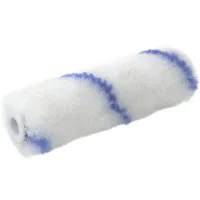Universal epoxy resin with slow hardener




- Laminating, coating, bonding
- 45-60 min. processing time
- Suitable for large jobs
RESION Universal epoxy with slow hardener is very suitable for coatings in combination with glass fabrics, coatings, floor and wall coatings, putty compounds and bonding pastes, among others. RESION Universal epoxy slowly gives an ample application time of 50 minutes and cures tack-free. RESION epoxy is always a set of epoxy resin combined with sufficient epoxy hardener.
Pigmenting
If required, you can also add epoxy pigment to pre-colour the epoxy in the right colour. Adding the pigments is very easy by adding about 3 to 5% epoxy pigment paste to the casting resin.
Fillers and reinforcement fibres
Epoxy resin can also be mixed with various fillers to obtain a mass as desired, such as an adhesive for bonding laminates, stony materials or wood, as well as to make putty. RESION Universal epoxy slow can also be processed with fabrics such as glass fabric, carbon fabric and aramid fabric.
The minimum processing temperature for this resin is around 12 degrees. Are you looking for an equivalent epoxy that can be processed from a temperature of around 4 degrees? The take a look at our Winter epoxy.
Specifications
| Unit | Resin (EP101) | Hardener (EP115) |
| 150 grams | 100 grams | 50 grams |
| 750 grams | 500 grams | 250 grams |
| 1.5 kg | 1 kg | 0.5 kg |
| 3 kg | 2 kg (2 x 1 kg) | 1 kg |
| 7.5 kg | 5 kg | 2.5 kg |
| 15 kg | 10 kg (2 x 5 kg) | 5 kg |
| 30 kg | 20 kg | 10 kg (2 x 5 kg) |
| 60 kg | 40 kg (2 x 20 kg) | 20 kg |
| 300 kg | 200 kg | 100 kg (5 x 20 kg) |
We also have a handy tap for the jerrycans (from 8 kg sets).
Fully cured: 24-28 hours (at 20°C)
Minimum processing temperature: 8℃
Shelf life: 1 year (at 15-20°C and stored in the dark)
We have a number of recommendations for working safely with polymers. At Polyestershoppen you will not only find the polymers themselves, but you can also purchase all the protective equipment you need from us. If you have any doubts or questions, please contact our customer service. We can give you advice on how to work safely with polymers.
EP101 | Epoxy BASE | 100 gram
Safety equipment




Waarschuwing
| Code | Description |
|---|---|
| H315 | Causes skin irritation. |
| H317 | May cause an allergic skin reaction. |
| H319 | Causes serious eye irritation. |
| H411 | Toxic to aquatic life with long lasting effects. |
| P101 | If medical advice is needed, have product container or label at hand. |
| P102 | Keep out of reach of children. |
| P261 | Avoid breathing dust/fume/gas/mist/vapours/spray. |
| P280 | Wear protective gloves/protective clothing/eye protection/face protection. |
| P302+P352 | IF ON SKIN: Wash with plenty of water/… |
| P333+P313 | If skin irritation or rash occurs: Get medical advice/attention. |
| P501B | Dispose of contents/container in accordance with in accordance with local regulation |
| P264A | Wash hands thoroughly after handling. |
| EUH205 | Contains epoxy constituents. May produce an allergic reaction. |


EP115 | Epoxy hardener SLOW | 50 gram
Safety equipment



Gevaar
| Code | Description |
|---|---|
| H314 | Causes severe skin burns and eye damage. |
| H317 | May cause an allergic skin reaction. |
| H302+H332 | Harmful if swallowed or if inhaled. |
| H412 | Harmful to aquatic life with long lasting effects. |
| P101 | If medical advice is needed, have product container or label at hand. |
| P102 | Keep out of reach of children. |
| P260 | Do not breathe dust/fume/gas/mist/vapours/spray. |
| P280 | Wear protective gloves/protective clothing/eye protection/face protection. |
| P303+P361+P353 | IF ON SKIN (or hair): Take off immediately all contaminated clothing. Rinse skin with water [or shower]. |
| P305+P351+P338 | IF IN EYES: Rinse cautiously with water for several minutes. Remove contact lenses, if present and easy to do. Continue rinsing. |
| P405 | Store locked up. |
| P501B | Dispose of contents/container in accordance with in accordance with local regulation |


- Epoxy for Beginners
- Casting an Object in Epoxy
- Mixing ratios and mixing of Epoxy and Polyester
- Personal Protective Equipment When Working with Resins
- Boat Repair and Restoration
- Treating Osmosis in 5 Steps [Guide]
- Covering EPS and XPS Foam With Epoxy
- Preparing a Wooden Floor for an Epoxy Floor Coating
- How Much Epoxy Do You Need?
- Successful Epoxy Casting? Avoid These 10 Mistakes!
- How to Laminate a Surfboard with Carbon Fibre and Epoxy
- FAQ - Working Safely With Epoxy
- The Temperature Resistance of Epoxy
- How to Cast Epoxy
- DIY Projects with Epoxy, Polyester, and PU Foam
- Troubleshooter: Epoxy Resin
- What Is the Difference Between Epoxy and Polyester?
- Thickening Epoxy and Polyester? How to Choose the Right Filler!





